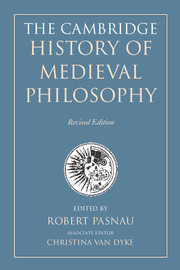Book contents
- Frontmatter
- Contents of Volume 1
- Preface
- List of contributors
- Frontmatter
- Contents of Volume 2
- Introduction
- I Fundamentals
- II Logic and language
- III Natural philosophy
- IV Soul and knowledge
- V Will and desire
- VI Ethics
- VII Political philosophy
- VIII Metaphysics
- IX Theology
- 50 Philosophy and theology
- 51 Faith and reason
- 52 Mysticism
- 53 Arguments for god’s existence
- 54 Describing god
- 55 Providence
- 56 The problem of evil
- Appendices
- Bibliography of primary sources
- Bibliography of secondary sources
- Index nominum
- Index rerum
- References
52 - Mysticism
from IX - Theology
Published online by Cambridge University Press: 05 August 2014
- Frontmatter
- Contents of Volume 1
- Preface
- List of contributors
- Frontmatter
- Contents of Volume 2
- Introduction
- I Fundamentals
- II Logic and language
- III Natural philosophy
- IV Soul and knowledge
- V Will and desire
- VI Ethics
- VII Political philosophy
- VIII Metaphysics
- IX Theology
- 50 Philosophy and theology
- 51 Faith and reason
- 52 Mysticism
- 53 Arguments for god’s existence
- 54 Describing god
- 55 Providence
- 56 The problem of evil
- Appendices
- Bibliography of primary sources
- Bibliography of secondary sources
- Index nominum
- Index rerum
- References
Summary
Current scholars generally behave as though the medieval traditions of mysticism and philosophy in the Latin West have nothing to do with each other; in large part, this appears to be the result of the common perception that mysticism has as its ultimate goal an ecstatic, selfless union with the divine that intellectual pursuits such as philosophy inhibit rather than support. There are, however, at least two central problems with this assumption.
First, mysticism in the Middle Ages – even just within the Christian tradition – was not a uniform movement with a single goal: it took different forms in different parts of Europe, and those forms changed substantially from the eleventh to the fifteenth century, particularly with the increased emphasis on personal piety and the feminization of religious imagery that emerges in the later centuries. The belief that mysticism entails the rejection or abandonment of reason in order to merge with the divine, for instance, represents only one strain of the medieval tradition. Although this view is explicitly advocated in the Christian West by such influential figures as Meister Eckhart and Marguerite Porete, the prevalent identification of the allegorical figure of Wisdom with Christ provides the grounds for equally prominent figures such as Hildegard of Bingen, Richard of St. Victor, and Henry Suso to claim that mystical union with God is actually aided by reason.
- Type
- Chapter
- Information
- The Cambridge History of Medieval Philosophy , pp. 720 - 734Publisher: Cambridge University PressPrint publication year: 2014

